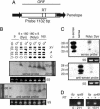Evidence for maternally transmitted small interfering RNA in the repression of transposition in Drosophila virilis
- PMID: 16247000
- PMCID: PMC1276106
- DOI: 10.1073/pnas.0508192102
Evidence for maternally transmitted small interfering RNA in the repression of transposition in Drosophila virilis
Abstract
Hybrid dysgenesis in Drosophila is a syndrome of gonadal atrophy, sterility, and male recombination, and it occurs in the progeny of crosses between males that harbor certain transposable elements (TEs) and females that lack them. Known examples of hybrid dysgenesis in Drosophila melanogaster result from mobilization of individual families of TEs, such as the P element, the I element, or hobo. An example of hybrid dysgenesis in Drosophila virilis is unique in that multiple, unrelated families of TEs become mobilized, but a TE designated Penelope appears to play a major role. In all known examples of hybrid dysgenesis, the paternal germ line transmits the TEs in an active state, whereas the female germ line maintains repression of the TEs. The mechanism of maternal maintenance of repression is not known. Recent evidence suggests that the molecular machinery of RNA interference may function as an important host defense against TEs. This protection is mediated by the action of endogenous small interfering RNAs (siRNAs) composed of dsRNA molecules of 21-25 nt that can target complementary transcripts for destruction. In this paper, we demonstrate that endogenous siRNA derived from the Penelope element is maternally loaded in embryos through the female germ line in D. virilis. We also present evidence that the maternal inheritance of these endogenous siRNAs may contribute to maternal repression of Penelope.
Figures




References
-
- Green, M. M. (1988) in Banbury Report, eds. Lambert, M. E., McDonald, J. F. & Weinstein, I. B. (Cold Spring Harbor Lab. Press, Plainview, NY), pp. 41-50.
-
- Charlesworth, B. & Langley, C. H. (1989) Annu. Rev. Genet. 23, 251-287. - PubMed
-
- Montgomery, E., Charlesworth, B. & Langley, C. H. (1987) Genet. Res. 49, 31-41. - PubMed
-
- Langley, C. H., Montgomery, E., Hudson, R., Kaplan, N. & Charlesworth, B. (1988) Genet. Res. 52, 223-235. - PubMed
Publication types
MeSH terms
Substances
Grants and funding
LinkOut - more resources
Full Text Sources
Molecular Biology Databases
Research Materials

